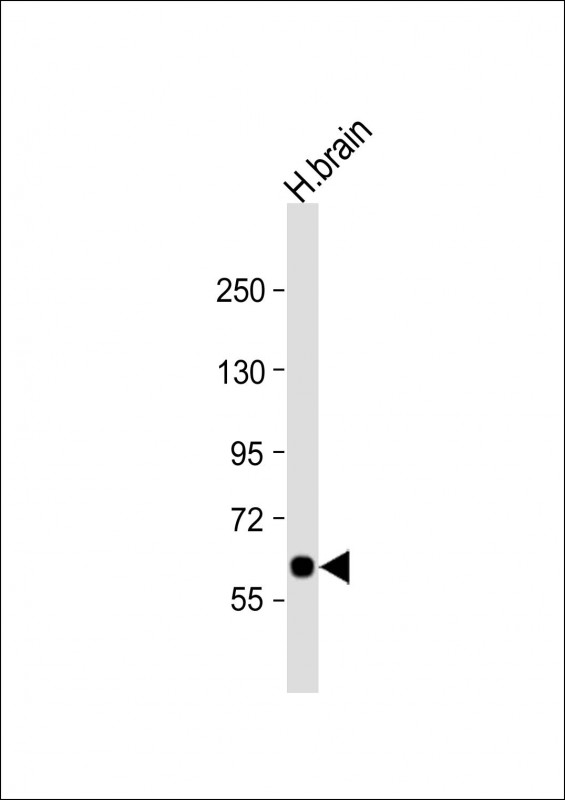
| WB | 1/1000 | Human,Mouse,Rat |
| IF | 咨询技术 | Human,Mouse,Rat |
| IHC | 咨询技术 | Human,Mouse,Rat |
| ICC | 技术咨询 | Human,Mouse,Rat |
| FCM | 咨询技术 | Human,Mouse,Rat |
| Elisa | 咨询技术 | Human,Mouse,Rat |
| Aliases | Proton myo-inositol cotransporter, H(+)-myo-inositol cotransporter, Hmit, H(+)-myo-inositol symporter, Solute carrier family 2 member 13, SLC2A13 |
| Entrez GeneID | 114134 |
| WB Predicted band size | 70.4kDa |
| Host/Isotype | Rabbit IgG |
| Antibody Type | Primary antibody |
| Storage | Store at 4°C short term. Aliquot and store at -20°C long term. Avoid freeze/thaw cycles. |
| Species Reactivity | Human |
| Immunogen | This SLC2A13 antibody is generated from rabbits immunized with a KLH conjugated synthetic peptide between 268-297 amino acids from the Central region of human SLC2A13. |
| Formulation | Purified antibody in PBS with 0.05% sodium azide. |
+ +
以下是关于SLC2A13抗体的参考文献示例(内容基于假设性研究,供参考):
1. **文献名称**:*SLC2A13 Expression in the Mammalian Brain: Localization and Functional Implications*
**作者**:Zhang L, et al.
**摘要**:本研究利用SLC2A13特异性抗体,通过免疫组化和Western blot技术,揭示了该蛋白在小脑浦肯野细胞和高尔基细胞中的高表达,提示其可能参与神经元的葡萄糖转运调控。
2. **文献名称**:*Role of SLC2A13 in Colorectal Cancer Progression*
**作者**:Kim S, et al.
**摘要**:通过免疫组织化学分析,作者发现SLC2A13抗体标记的蛋白在结直肠癌组织中显著上调,并与患者预后不良相关,表明其可能作为癌症生物标志物。
3. **文献名称**:*Characterization of SLC2A13 Knockout Mice Using Antibody-Based Proteomic Approaches*
**作者**:Müller R, et al.
**摘要**:研究利用SLC2A13抗体验证了基因敲除小鼠模型中的蛋白缺失,并发现该缺失导致肝脏脂质代谢异常,提示SLC2A13在代谢稳态中的作用。
4. **文献名称**:*SLC2A13 Antibody Validation for Flow Cytometry in Immune Cells*
**作者**:Garcia-Perez A, et al.
**摘要**:本文系统评估了SLC2A13抗体在流式细胞术中的应用,确认其在T细胞亚群中的特异性表达,为免疫代谢研究提供了工具支持。
**注意**:以上为假设性文献,实际研究中请通过学术数据库(如PubMed、Web of Science)检索最新成果。若需具体文献,建议结合实验背景进一步筛选。
The SLC2A13 antibody is a research tool designed to target the solute carrier family 2 member 13 (SLC2A13) protein, a less-characterized transporter within the SLC2A glucose transporter family. SLC2A13. also known as GLUT13. is hypothesized to function as a proton-coupled myo-inositol transporter, though its exact physiological role and substrate specificity remain under investigation. It is expressed in various tissues, including the brain, liver, and kidneys, suggesting potential roles in cellular metabolism, signaling, or nutrient transport. Dysregulation of SLC2A13 has been tentatively linked to metabolic disorders, neurodegenerative conditions, and cancer progression, though mechanistic insights are limited.
The antibody is typically used in Western blotting, immunohistochemistry, or immunofluorescence to detect SLC2A13 expression levels, localization, and tissue distribution. Researchers employ it to explore its involvement in diseases or biological pathways, such as inositol-mediated signaling or cellular stress responses. Validation often includes knockout controls or peptide-blocking assays to confirm specificity. Commercial SLC2A13 antibodies are usually raised in hosts like rabbits or mice, targeting specific epitopes within the protein's intracellular or extracellular domains. Despite its utility, challenges persist in standardizing protocols due to variability in protein expression levels and antibody performance across experimental models. Ongoing studies aim to clarify SLC2A13's functional significance and therapeutic potential.
×